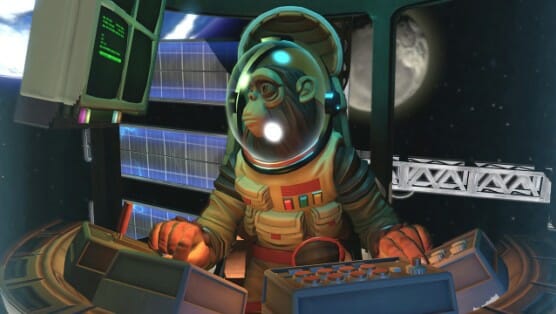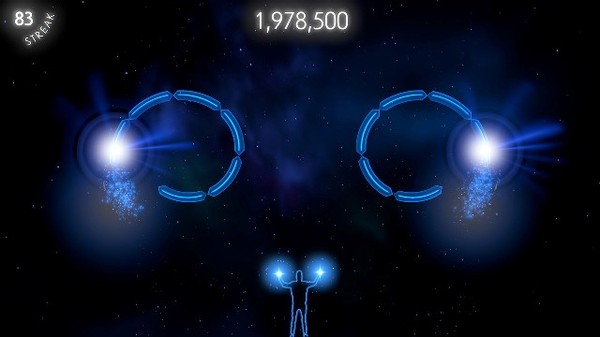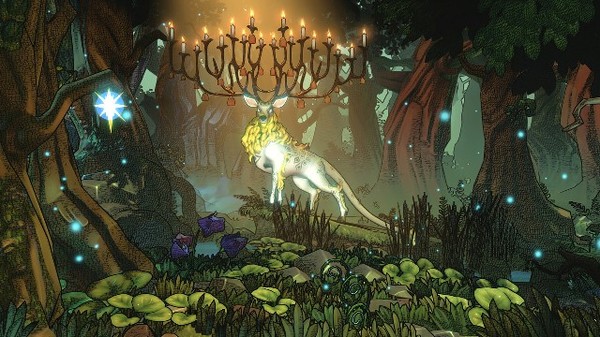
The best thing about Fantasia: Music Evolved is that a videogame with Disney’s name on it, that’s advertised heavily with recent Top 40 hits, and that seems so desperate to win over a marketer’s idea of modern day “cool kids”, could still be so weird. The commercials might want us to think about Dance Central, but there isn’t anything that I can easily compare this game to.
This is a weird game, a beautiful, exciting, surprising, weird game. It may not challenge its audience as much as Disney’s movie does, but it experiments with the form of a music game as much as Fantasia did with the relationship between sound and image. It can’t match the movie for vision or power, but it doesn’t really try to, content to merely upend what we expect from both a Fantasia game and a music game from Harmonix. It can be as physically euphoric as Dance Central, Harmonix’s last series for the Kinect, but it’s rich with a sense of childlike wonder that can’t be found in a dance club. Did I mention it’s weird?
Fantasia: Music Evolved hinges entirely upon the arms. I play by waving them around in front of the Kinect, vertically slicing the air or swooping at angles based on what the screen tells me to do. It’s the rhythm game equivalent of conducting an orchestra. I listen to the music, which includes both classical pieces and pop songs from various eras, and try to keep time with both the beat and the on-screen prompts. I have to time my Ric Flair knife-edged chops with arrows as they fly through small streaks of color on screen. When I find the rhythm points are scored and a streak counter ticks up.
My arms do more than chop. I slowly trace on-screen outlines with my hands, or hold them steady as circles fill up with glowing energy. Sometimes I punch dead on with a closed fist. There are only a few basic motions, but it’s easy to lose track of the pacing and order as arrows quickly materialize and disappear on the harder and more rhythmically complex songs.
If that’s all there was to Fantasia: Music Evolved, it’d be an interesting curio that I’d play fitfully over a few days before never loading up again. The core of the game isn’t pantomiming Leopold Stokowski conducting a Drake song, but remixing songs as I do so. This is where the game’s power and weirdness both appear in full, along with its deep potential for repeated play.
Throughout each song moments occur where I can punch towards the screen and select between three different mixes. There are three full versions of every song in the game, each in a notably different musical style, and I can mix and match instruments from all three mixes throughout each play session. When I jazzhand my way through New Order’s “Blue Monday”, I can swap out the original sounds with strings and a piano, or replace the Oberheim DMX drum machine with a more modern piece of tech. One of the remixes for Peter Gabriel’s “In Your Eyes” sounds like a Little Feat cover of Peter Gabriel’s “In Your Eyes”. I can give Dvo?ák’s Symphony No. 9, one of the most recognizable and enduring pieces of music ever written, the beat from an NES game. I can weave all these different instruments from these different mixes together throughout the song, crafting my own mix from the tools that Harmonix provides.
If I was a stickler I could find fault with the fact that I can’t record and add my own stems to these songs. Obviously I don’t have the freedom to remix them the way Harmonix did, or the way professional DJs and producers do when they’re provided access to the original masters and equipment with which to do their work. This is a game. It’s a toy. It isn’t a sequencer or Ableton Live. I’m restricted to what Harmonix lets me do, but they let me do more than enough to stay fascinated by the possibilities.
Those possibilities are increased by tools that let me manipulate sounds and add my own short samples to the mix. I can stretch and squeeze a musical staff to speed up or slow down a solo, tilting it at different angles to change the pitch. I can run my on-screen cursor across an orb that turns an octave of chopped up notes from the song into a new melody. I can spiral both hands around a tunnel, Tempest-style, stuttering and splicing together vocal samples. These new passages are filtered seamlessly into the song for the rest of my mix, letting me add a small personal touch to the proceedings. These additions don’t last past that playthrough, but I can save each performance to my Xbox One for future listening. Also the game will offer the ability to share performances on YouTube, although that feature wasn’t active yet while I played the game.
Beyond the name, the presence of the sorcerer Yensid, and the interplay of music and images, there’s not a lot that directly connects the game to the movie. Three of the pieces from the film are playable, including excerpts from Mussorgsky’s Night on Bald Mountain and Tchaikovsky’s Nutcracker Suite, but the images that play behind them on the screen don’t reference visuals from the film. The closest the game gets to looking like the movie is my silhouette echoing that of Stokowski, the film’s conductor, and how the game’s environments are formed by audiowaves when selected from the main menu. These levels present different art-styles that often invoke classic Disney concepts, from the Tomorrowland-esque retrofuturism of the Capsule to the European storybook illustrations of the Hollow. The artwork is often gorgeous, from the stag with a candelabra for antlers, to the hectic jazz age printing press. Each environment has hidden musical toys I can play with, like suits of armor that clank at different tones when I wave over them, or clams that play jazz drums. Like the music manipulators, I can record short passages on these makeshift instruments, and hear them playing in the level’s background music from then on.
Fantasia: Music Evolved isn’t about turning music into a sequence of buttons to mash, or about the nostalgia of a classic movie. It’s about exploring music and the possibilities of sound, letting me literally reshape them with my hands. The end result is one of the most exhilarating games I’ve ever played. I’m bouncing around, working up my heart rate, hurling my arms in every direction, pulling in keyboards and clarinets, muting guitars and drum machines, sculpting solos with my hands, and feeling a connection to music and to a game that I’ve never felt before. It’s not like dancing, and it’s not like playing in a band or DJing at a bar. It’s something entirely different, something special and, yes, something weird.
Fantasia: Music Evolved was developed by Harmonix and published by Disney Interactive Studios. Our review is based on the Xbox One. It is also available for Xbox 360.
Garrett Martin edits Paste’s games section and is going to Disneyland in like three weeks.

